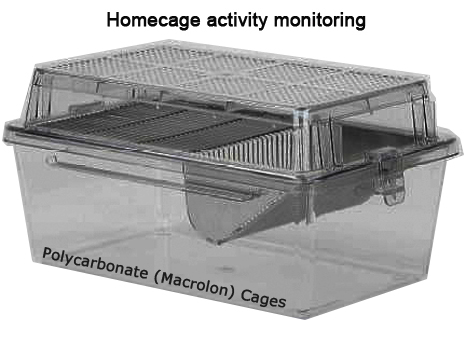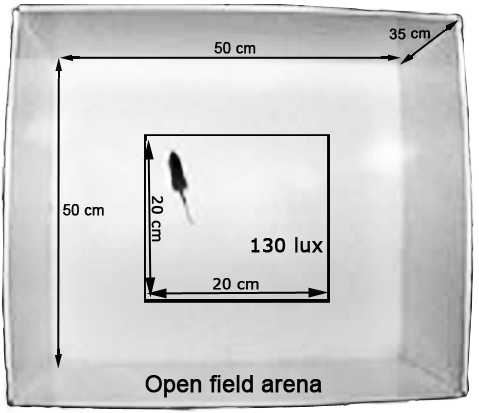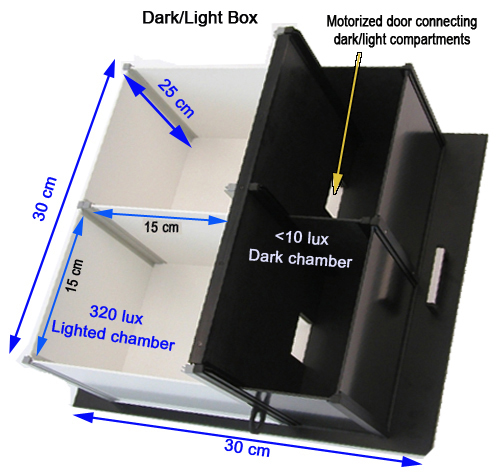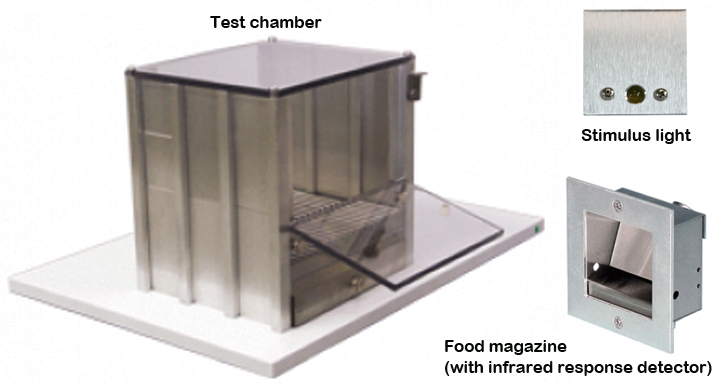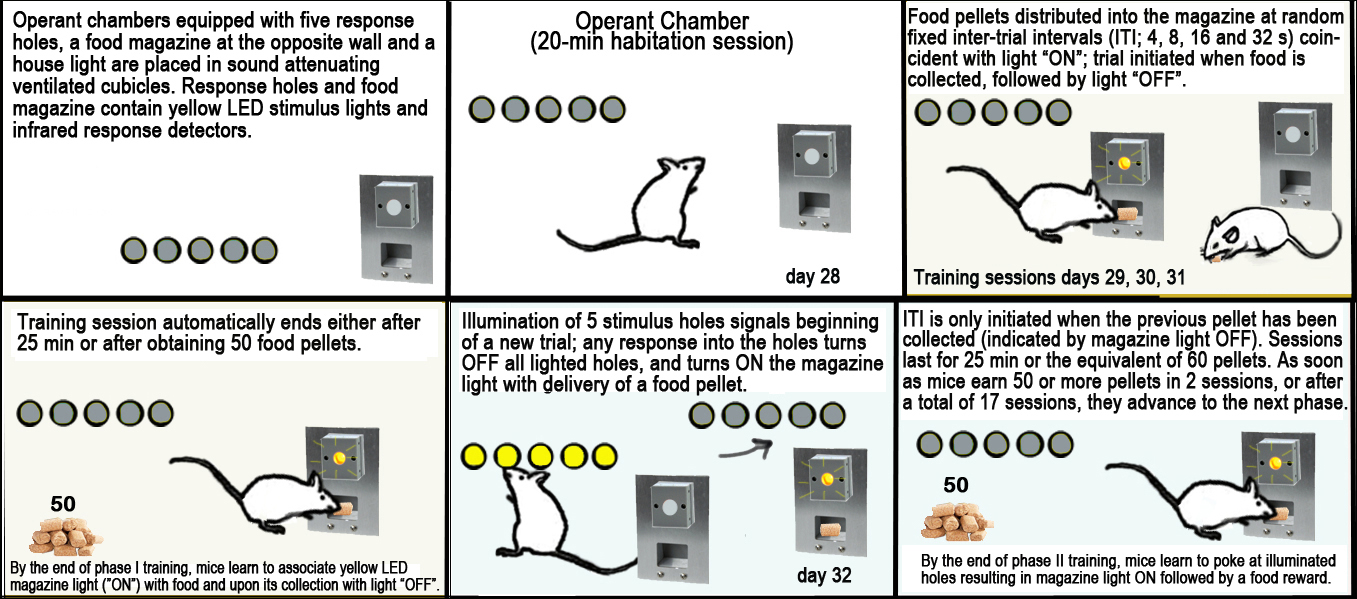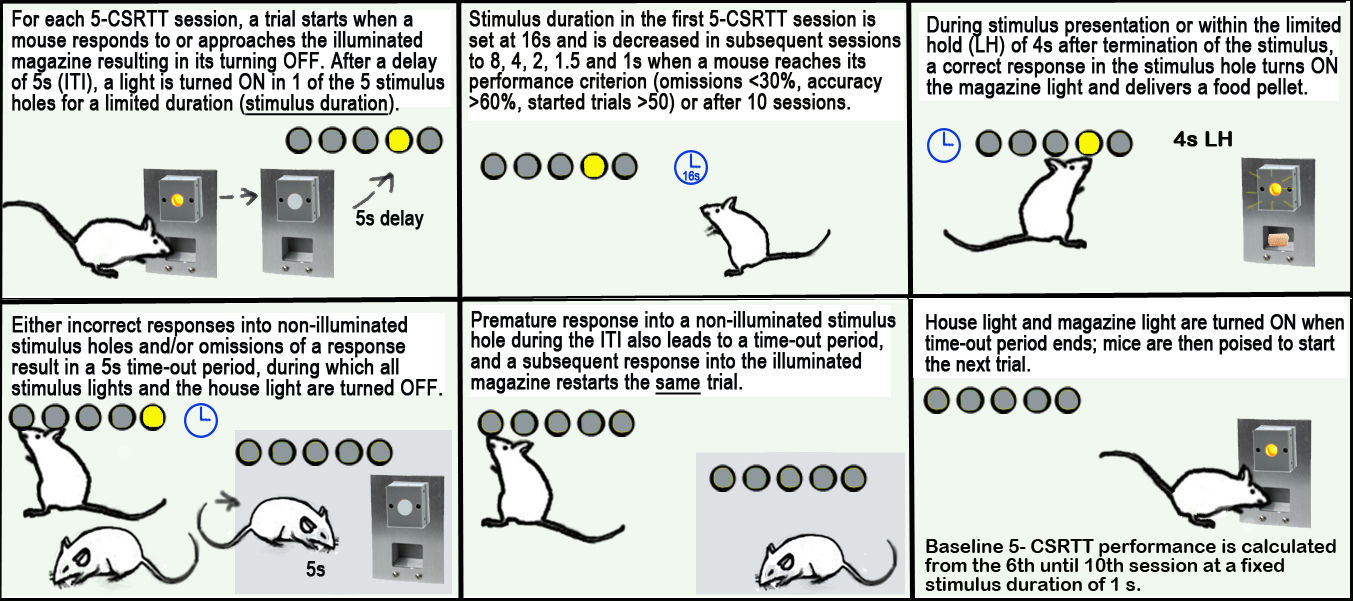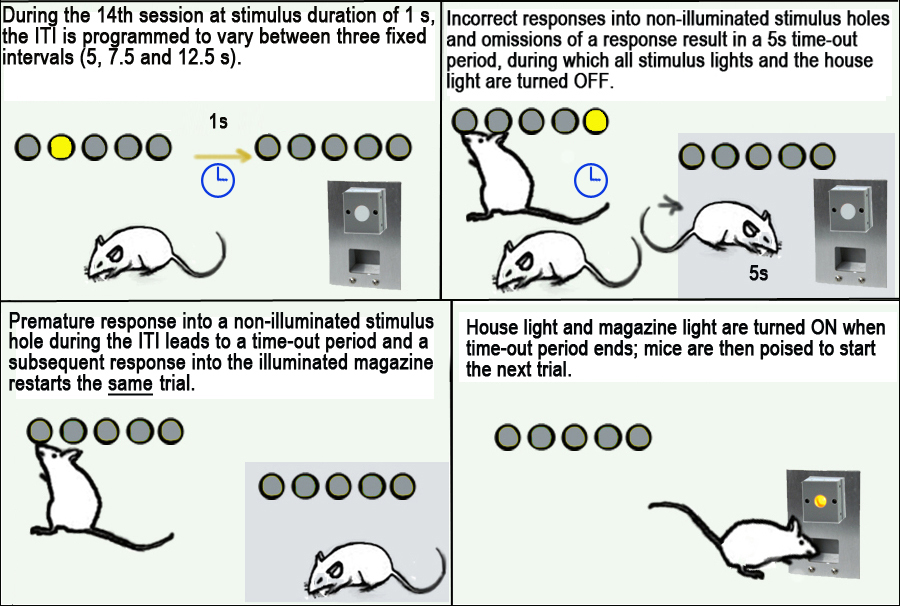Spijker2 project protocol
Activity, exploration, and impulsivity in 12 mouse strains (2009)
Spijker SWith: Loos M, van der Sluis S, Bochdanovits Z, van Zutphen IJ, Pattij T, Stiedl O, Smit AB, Neuro-BSIK Mouse Phenomics Consortium
Project protocol — Contents
Workflow and sampling
Equipment and supplies
Reagents and solutions
Procedure: Home cage behavior
Procedure: Novel cage behavior
Procedure: Open field test
Procedure: Dark/light box
Procedure: Elevated plus maze
Procedure: 5-Choice serial reaction time task (5-CSRTT)
Definitions
Data
ReferencesWorkflow
Mice transferred to novel clean cage with fresh bedding and containing metal cup with familiar snack (Fig. 2 left panel) Mice transferred to novel clean cage with fresh bedding and containing metal cup with familiar snack (Fig. 2 left panel) Mice introduced into a corner of the white square of an open field arena (Fig. 3) Mice food-restricted to gradually decrease body weight to 90% of free feeding weight before exposure to 5 choice serial reaction time task (5-CSRTT) Mice habituated to 5-CSRTT operant chamber for 20 min (wk 1) (Figs. 6 and 7) Mice trained to retrieve reward pellets distributed into food magazine at random fixed inter-trial intervals (wk 1) Fig. 7) Mice trained to perform an instrumental response into stimulus holes to earn a reward (wk 2) (Fig. 8) Mice tested with fixed stimulus duration beginning at 16s and decreasing to 1s (Fig. 9) Mice challenged within a variable stimulus duration occurring at an equal number of times within session (Fig. 10) *All mice were subjected to all behavioral tests, and the order of the tests is identical for all mice.
• Home cage (Fig. 1)
Fig. 1. An example of a Macrolon home cage.
• Novel clean cage and objects (Fig. 2)
Fig. 2. Depiction of clean novel cages with familiar snack in a metal food cup presented on days 4 and 11 (left), novel objects presented separately on days 7 and 9 (middle), and familiar snack with unfamiliar glass cup presented on day 8 (right).
• Open field arena: custom-built, white acrylic (50 x 50x 35 cm, Fig. 3) with automated tracking EthoVision software 3.0, Noldus Information Technology
Fig. 3. Aerial view of an open field arena.
• Dark/light box: custom-built 25 x 30 x 30 cm Dark/Light box (TSE-Systems). The box is partitioned equally with an acrylic sheet 15 x 30 cm, such that approximately half (15 x 15 x 25 cm) of the total area is under low lighting (<10 lux) representing the dark compartment and the remaining half is brightly lit (320 lux) with white light, serving as the light compartment (Fig. 4). A small motorized black door opening within the partition allows mice to move freely between chambers.
Fig. 4. Schematic of the Dark/light box showing brightly lit light compartment and the dark compartment, where the mouse is hiding.
• Elevated plus maze (Fig. 5): Constructed from black opaque acrylic, with each arm measuring 30 x 6 cm and the central platform 6 x 6 cm. One set of arms, opposing one another, are enclosed completely by a wall of transparent acrylic, 30 cm high, while the other set is open on either side of the arms (panels A and B). The maze is elevated 50 cm from the ground, illuminated with a single white fluorescent light bulb from above (130 lux), and equipped with video tracking system (EthoVision 3.0, Noldus Information Technology) (panel C).
Fig. 5. Ground view (panel A) and aerial view (panel B) of the elevated plus maze apparatus showing closed arms (safe zone) and open arms (exploratory zone). Exploratory behavior is videographed and analyzed using EthoVision (panel C).
- Operant chambers (Fig.6): Equipped with five response holes, a food magazine at the opposite wall and a house light, and placed in sound attenuating ventilated cubicles. Both response holes and food magazine contain yellow LED stimulus lights and infrared response detectors (MEDNPW-5M, Med Associates, St Albans, VT, USA).
Fig. 6. Example of test chamber, stimulus light, and food magazine used in conducting five-choice serial reaction time task (5-CSRTT).- Metal and glass food cups
- Novel objects: metal spout and blue plastic bottle cap
- Cleaning supplies
- Formula P (Research Diets, New Brunswick, NJ, USA)
- Palatable snacks
- 70% alcohol
- Disinfectant solution: 1% Trigene®
Procedure for conducting a battery of behavioral tests
Below, days are numbered with respect to the first testing day.
Procedures common to all behavioral tests
a. Mice are habituated to the home cage and on 4 separate days presented a highly palatable snack (cream crackers) placed in a metal food cup.
b. The battery of behavioral tests is identical and conducted in order from the least to most stressful for all mice (see workflow above).
c. All tests are performed between 0800 and 1200 h.
d. Housing and testing rooms (4 m apart) are separated by 2 sound attenuating doors.
e. Mice are transferred one-at-a-time from the housing room to the testing room and immediately introduced to the test apparatus.
f. With the exception of daily training for the 5-CSRTT, the same experimenter is assigned to perform all tests.
g. Each apparatus is wiped clean between subjects to avoid olfactory cueing influencing activity and behavioral performances.a. For the first 3 test days, a familiar snack is introduced into the familiar metal food cup placed within the home cage, and the latency to start eating is scored (Fig. 1).
b. Mice not eating after 240 s are assigned the maximum latency. Mean latency to eat is calculated over 3 days.
c. On days 7 and 9, novel objects (metal spout and a blue plastic bottle cap, respectively) are introduced into the home cage.
d. Both latency until first touch of the object and cumulative time touching the object during 4 min are recorded manually.
e. Mice failing to touch the novel objects are assigned the maximum latency of 240 s.
f. For both novel object sessions, the mean is used for analysis.
g. On day 8, the familiar snack is introduced into the home cage in an unfamiliar glass cup.
h. Latency to first touch the unfamiliar glass cup, total duration exploring the unfamiliar glass cup before eating, and latency to eat the snack are recorded for a maximum of 10 min.
i. Mice failing to touch or explore the unfamiliar glass cup are assigned the maximum latency of 600 s.
j. Mice failing to eat the snack are assigned the maximum latency of 600 s.II-Novel cage
a. On days 4 and 11, mice are transferred to a novel clean cage (Fig. 2) with fresh bedding containing the metal cup with the familiar snack.
b. Latency to first touch the familiar metal cup and latency to start eating the familiar snack are both manually recorded.
c. Mean performance on both days is used for analysis.
d. Maximum time of 720 s (12 min) is assigned if a mouse fails to eat.
e. After testing, both nesting material and environmental enrichment tube are transferred to the novel cage, making it a new home cage.III-Open field (OFT)
a. On day 14, mice are placed into a corner of the white square of the open field arena illuminated with a single white fluorescent light bulb from above (130 lux) and exploration is tracked for 10 min (12.5 frames/s) (Fig. 3).
b. Number of entries into the center square area, and duration spent within are measured using EthoVision.
c. The Strategy for the Exploration of Exploration software (SEE) is used to smoothen path shape to calculate the total distance moved. SEE uses the distribution of speed peaks to parse the locomotor data into slow local movements (lingering episodes) and progression segments, which together constitute total distance traveled.
d. SEE is used to calculate the number of progression segments and the median duration of a lingering episode to describe the animal tendency to engage in exploratory behavior.
e. SEE is also used to calculate measures that describe the strategy of movement once exploration has been initiated: the median distance traveled per progression segment, the median duration of a progression segment, the number of stops per distance and the median acceleration during a progression.a. On day 15, mice are placed into the dark compartment of a Dark/light box (Fig. 4).
b. A motorized black door to the light compartments is opened 15 s later and behavior is tracked for 5 min using infrared beams (1.4 cm apart).
c. Latency to enter the light compartment, number of entries into the light compartment, and time spent in the light compartment are extrapolated based on complete transitions between dark and light compartments.a. On days 16 or 17, mice are introduced into the same closed arm of an EPM, facing the closed end of the arm (Fig. 5).
b. The EPM is illuminated with a single white fluorescent light bulb from above (130 lux) and exploratory behavior is video tracked for 5 min (12.5 frames/s).
c. The border between center and arm entries is defined at 2 cm into each arm.
d. Number of entries into the open arms, into the closed arms, onto the center platform, and time spent on the open arms are extrapolated from the video recordings.
e. Latency to explore is defined by the time between introduction onto the maze and the first appearance in the maze center.VI-Five-choice serial reaction time task (5-CSRTT)
1. Training phases 1-2 (first week) (Fig. 7) Mice are trained to perform the 5-CSRTT task on an individually paced schedule in operant chambers.
a. Mice previously food-restricted to gradually decrease their body weight to 90% of their free feeding weight are trained to perform the 5-CSRTT task.
b. Mice are habituated to the operant cages for one session of 20 min, during which the house light is switched OFF, and the stimulus lights in the magazine and stimulus holes are turned OFF.
c. On days 29-31, purified precision pellets (12 mg of Formula P) are distributed into the magazine at random fixed inter-trial intervals (ITI; 4, 8, 16 and 32 s), which coincide with switching ON the magazine stimulus light.
d. An ITI is only initiated when the previous pellet has been collected as indicated by a magazine response, during which the magazine stimulus light is turned OFF.
e. A session ends after 25 min or sooner when the criterion of 50 pellets is reached.
f. During the 3rd day session, the mean number of responses into the empty non-illuminated magazine is recorded for further analyses.
g. In subsequent sessions, a trial is started by the illumination of all 5 stimulus holes.
h. A response into any of the 5 illuminated holes switches OFF the light in all 5 stimulus holes, switches ON the stimulus light in the magazine, and delivers a food pellet into the magazine.
i. After the previous pellet is collected as indicated by a magazine response, an ITI is initiated and the magazine stimulus light is turned OFF.
j. Although each sessions lasts for 25 min or 60 earned food pellets, as soon as a mouse earns 50 or more pellets in two sessions, or after 17 sessions, it moves to the next phase.
Fig. 7. Schematic representation of the first week of 5-CSRTT training consisting of a habituation period and 4 magazine training sessions.2. Training phase 3 (second week) (Fig. 8)
a. On days 35-38, mice are trained to perform an instrumental response into the stimulus holes to earn a reward.
b. Trials are started by the illumination of only one stimulus hole.
c. Correct responses into illuminated holes earns a reward; responses into non-illuminated holes are without consequence.
d. As soon as mice earn 50 or more pellets in two sessions, or after 10 sessions, they are done with the training phase.
Fig. 8. Schematic representation of the second week of 5-CSRTT training to perform an instrumental response into the stimulus holes to earn a reward.3. Five-choice serial reaction time tasks (5-CSRTT) training toward a fixed stimulus duration of 1 s (to Fig. 9)
a. On day 39, a trial is started when a mouse makes a response into the illuminated magazine, which in turn, switches OFF magazine light, and after an inter-trial interval (ITI) delay of 5 s, a stimulus in one of the five stimulus holes is switched ON for a limited stimulus duration initially as long as 16 s.
b. When a mouse makes a response in the correct stimulus hole, during stimulus presentation, or within the limited hold of 4 s after termination of the stimulus, the magazine light is switched ON and a food pellet reward is delivered.
c. When a mouse responds either incorrectly into non-illuminated stimulus holes and/or fails to make a response, it is subjected to a 5 s time-out period, during which all stimulus lights and the house light are switched OFF.
d. When the time-out period ends, both the house light and the magazine light are switched ON and the mouse starts the next trial.
e. If a mouse makes a premature response into a non-illuminated stimulus hole during the ITI, it is also subjected to a 5 s time-out period, and a subsequent response into the illuminated magazine restarts the same trial.
f. When the time-out period ends, both the house light and the magazine light are switched back ON and the mouse is poised to start the next trial.
g. For subsequent 5-CSRTT sessions, the stimulus duration is gradually decreased to 8, 4, 2, 1.5 and 1 s when reaching the set criterion (omissions < 30%, accuracy > 60%, started trials > 50) or after 10 sessions at the same stimulus duration.
h. Dependent measures or baseline 5-CSRTT performance is calculated from the 6th until 10th session at a fixed stimulus duration of 1 s, and the average of these sessions is used as standard 5-CSRTT performance.
i. During these baseline sessions, the average latency to collect food reward from the magazine following a correct response is recorded and used for further analyses (calculated only if a mouse responds correctly five times during one or more baseline sessions).
Fig. 9. Schematic workflow of the 5-CSRTT toward a fixed stimulus duration of 1 s, beginning with 16 s.4. Five-choice serial reaction time tasks (5-CSRTT) with variable inter-trial intervals (Fig. 10)
a. On day 40, an inter-trial interval (ITI) is programmed to vary between three intervals (5, 7.5 and 12.5 s) during the last 10 sessions at fixed stimulus duration of 1 s, with each interval occurring an equal number of times for all mice.
b. Latency to collect food reward is calculated and compared with baseline.
Fig. 10. Schematic workflow of the five-choice serial reaction time task (5-CSRTT) at variable stimulus durations.Data collected and submitted by investigatoranticipatory magazine responses = number of incorrect responses and the detection of a head entry into the magazine
response accuracy = 100 x [(number of correct responses) / (number of correct and incorrect responses)]
percentage of omissions = 100 x [(omissions) / (omissions + number of correct and incorrect responses)]
percentage of premature responses (impulsivity) = 100 x [(number of premature responses) / ((omissions) + (number of correct and incorrect responses))]
latency to collect food reward (magazine latency) = latency between a correct response and the detection of a head entry into the magazine
Home cage behavior (HC)
- exploring novel object, latency
- exploring novel object with food, latency
- eating from familiar object, latency
- eating from novel object, latency
- exploring novel object, duration
- exploring novel object with food, duration
Novel cage behaviors (NC)
- exploring novel object with food, latency
- eating from familiar object, latency
Open Field Test (OFT)
- total distance
- stops
- acceleration
- distance per progression
- number of progressions
- duration of progression
- lingering episode
- center occupancy, duration
- center occcupancy, entries
Dark-light box (LD)
- light zone occupancy, duration
- light zone occupancy, entries
- light zone occupancy, latency
Elevated Plus Maze (EPM)
- total distance
- center occupancy, entries
- center occupancy, latency
- open arms occupancy, duration
- open arms occupancy, entries
- closed arms occupancy, entries
Five-choice serial reaction time task (5-CSRTT)
- anticipatory response
- latency to collect food
- impulsivity
